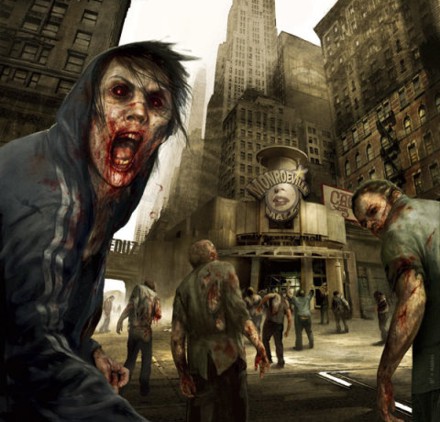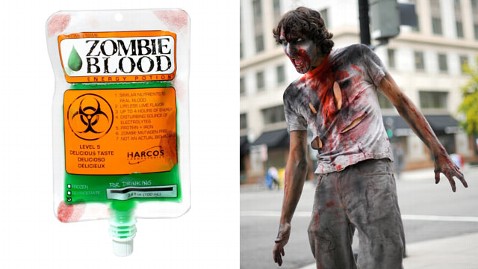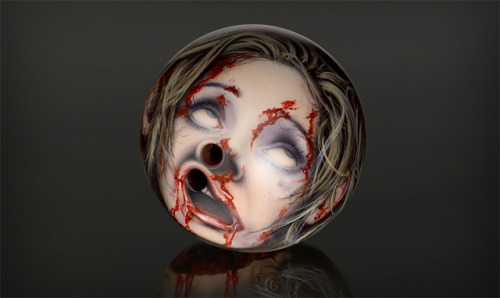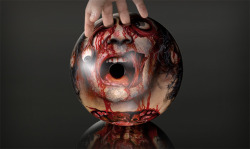Tag Archives: zombies
ZOMBIE HISTORY – The Plague That Is Zombies
 ‘I hereby resolve to kill every vampire in America” writes the young Abraham Lincoln in the best-selling 2010 novel “Abraham Lincoln: Vampire Hunter.” Honest Abe doesn’t quite make good on his promise, and the grim results are all around us. Today, vampires spring from the shadows of our popular culture with deadening regularity, from the Anne Rice novels to the Twilight juggernaut to this year’s film adaptation about the ghoul-slaying Great Emancipator. Lately we’ve also endured a decadelong bout with the vampire’s undead cousin, the zombie, who has stalked films from “28 Days Later” to “Resident Evil” (the next sequel of which is due out this fall) and the popular TV show “The Walking Dead.”
‘I hereby resolve to kill every vampire in America” writes the young Abraham Lincoln in the best-selling 2010 novel “Abraham Lincoln: Vampire Hunter.” Honest Abe doesn’t quite make good on his promise, and the grim results are all around us. Today, vampires spring from the shadows of our popular culture with deadening regularity, from the Anne Rice novels to the Twilight juggernaut to this year’s film adaptation about the ghoul-slaying Great Emancipator. Lately we’ve also endured a decadelong bout with the vampire’s undead cousin, the zombie, who has stalked films from “28 Days Later” to “Resident Evil” (the next sequel of which is due out this fall) and the popular TV show “The Walking Dead.”
Purists will hold forth on the differences between vampire and zombie, but the family resemblance is unmistakable. Both are human forms seized by an animal aggression, which manifests itself in an insatiable desire to feed on the flesh of innocents. (Blood, brains, whatever; it’s a matter of taste.) Moreover, that very act of biting, in most contemporary versions of both myths, transforms the victims into undead ghouls themselves.
Our vampires and zombies (as well as such poor relations as werewolves) all serve as carriers for vaguely similar saliva-borne infections. These mythical contagions are especially odd because they have so few analogues in the natural world. Indeed, there is really only one: the rabies virus.
A fatal infection of the brain, rabies is particularly devastating to the limbic system, one of the most primitive parts of the brain. Fear, anger and desire are hijacked by the virus, which meanwhile replicates prolifically in the salivary glands. The infected host, deprived of any sense of caution, is driven to furious attack and sometimes also racked with intense sexual urges. Today we know that most new diseases come from our contact with animal populations, but with rabies this transition is visible, visceral, horrible. A maddened creature bites a human, and some time later, the human is seized with the same animal madness.
Known and feared for all of human history—references to it survive from Sumerian times—rabies has served for nearly as long as a literary metaphor. For the Greeks, the medical term for rabies (lyssa) also described an extreme sort of murderous hate, an insensate, animal rage that seizes Hector in “The Iliad” and, in Euripides’ tragedy of Heracles, goads the hero to slay his own family. The Oxford English Dictionary documents how the word “rabid” found similar purchase in English during the 17th century, as a term of illness but also as a wrenching state of agitation: “rabid with anguish” (1621), “rabid Griefe” (1646).
The roots of the vampire myth stretch back nearly as far. Tales of vampire-like creatures, formerly dead humans who return to suck the blood of the living, date to at least the Greeks, before rumors of their profusion in Eastern Europe drifted westward to capture the popular imagination during the 1700s.
In its original imagining, though, the premodern vampire differed from today’s in one crucial respect: His condition wasn’t contagious. Vampires were the dead, returned to life; they could kill and did so with abandon. But their nocturnal depredations seldom served to create more of themselves.
All that changed in mid-19th century England—at the very moment when contagion was first becoming understood and when public alarm about rabies was at its historical apex. Despite the fact that Britons were far more likely to die from murder (let alone cholera) than from rabies, tales of fatal cases filled the newspapers during the 1830s. This, too, was when the lurid sexual dimension of rabies infection came to the fore, as medical reports began to stress the hypersexual behavior of some end-stage rabies patients. Dubious veterinary thinkers spread a theory that dogs could acquire rabies spontaneously as a result of forced celibacy.
Thus did rabies embody the two dark themes—fatal disease and carnal abandon—that underlay the burgeoning tradition of English horror tales. Britain’s first popular vampire story was published in 1819 by John Polidori, formerly Lord Byron’s personal physician. The sensation it caused was due largely to the fact that its vampire, a self-involved, aristocratic Lothario, distinctly resembled the author’s erstwhile employer.
But Polidori’s Byronic ghoul only seduced and killed. It took until 1845, with the appearance of James Malcolm Rymer’s serialized horror story “Varney the Vampire,” for the vampire’s bite to become a properly rabid act of infection. For the first time readers were invited to linger on the vampire’s teeth, which protrude “like those of some wild animal, hideously, glaringly white, and fang-like.” And at the long tale’s end, Varney’s final victim (a girl named Clara) is herself transformed into a vampire and has to be destroyed in her grave with a stake.
Both these innovations carried over into the most important vampire tale of all, Bram Stoker’s “Dracula.” In Stoker’s hands, the vampire becomes a contagious, animalistic creature, and his condition is properly rabid. It is a lunge too far to claim (as one Spanish doctor has done in a published medical paper) that the vampire myth derived literally from rabies patients, misunderstood to be the walking dead. But it is clear that this central act of undead fiction—the bite, the infection, the transferred urge to bite again—has rabies knit into its DNA.
Over time, the vampire’s contagion infected his undead cousin, too. The original zombie myth, as it derived from Haitian lore, also involved the dead brought back to kill, but again without contagion—an absence that carried over to Hollywood’s earliest zombie flicks. In this and many other regards, the most influential zombie tale of the 20th century was nominally a vampire tale: Richard Matheson’s 1954 novel “I Am Legend,” whose marauding hordes of contagious “vampires,” victims of an apocalyptic infection, set the whole template for what we now think of as the standard zombie onslaught.
Since then, as Hollywood has felt the need to conjure ever more frightening cinematic menaces, the zombie has if anything grown increasingly rabid. The antagonists in Matheson’s novel can, at times, carry on an intelligent conversation with a normal human. By the 2007 film adaptation, starring Will Smith, the infected are howling, lunging, senselessly hateful animals inside a human form. Danny Boyle, the director of “28 Days Later,” has said outright that he modeled his zombie virus on rabies. But even if he hadn’t consciously done so, the name he gave that virus—”Rage”—already draws its power from the same centuries-old supply.
Westerners don’t have much cause to fear death from rabies these days. Thanks to the availability of vaccine, human fatalities in the U.S. have dropped to a handful per year; Britain got rid of the virus entirely in 1902, succeeding in just the sort of national eradication project that apparently stymied the vampire-slaying Abraham Lincoln. Yet the infected bite, the human turned animal aggressor, menaces us as often as ever on our flat screens and nightstands.
Rabies itself may be a distant concern, but the rabid idea, like Varney the vampire, still has teeth—and it still succeeds in spreading itself.
LOLLIPOP CHAINSAW – Juliet Starling Zombie Slaying Super Babe REAL!!!
Lollipop Chainsaw superbabe Juliet Starling has been spotted hacking zombies!








Check out her facebook page here
https://www.facebook.com/OfficialJessicaNigri
When Zombies invite themself at Bowling- COOLEST THING FOR THE Z-POC
magine play bowling with the head of a zombie as a ball… When Zombies invite themselves at Bowling, a superb campaign for the German version of horror chanel 13th Street, which once again takes up the theme of zombie for its communication (like this previous campaign: Zombies on 13th St
Just when you thought nothing could make bowling any cooler, here come the zombies.

Exploding Bags of ‘Zombie Blood’ Lead to Lawsuit

Zombie blood is supposed to be gross, but not this gross.
A company that sells the novelty beverage “Zombie Blood,” green fluid sold in an IV style package, is suing the firms that manufacture and package the drink, claiming errors made the product stink and the bags explode.
Harcos Labs, which sells Zombie Blood and the similarly packaged red beverage aptly known as “Blood,” accuses the companies Primal essence, Power Brands Consultants, American Bottling, and Silliker, which tests products, of using the wrong ingredients, resulting in the product’s foul smell and spoilage.
“A number of initial production runs of the ‘Blood’ and ‘Zombie Blood’ met with a phenomenal success, they virtually flew off the shelves at such retailers as Hot Topic and sold out quickly,” Harcos said in its suit against the other firms.
” However, in late August 2010, Harcos first learned of the complaints of the Zombie Blood product tasting ‘like yogurt.’ In late September 2010, Harcos first learned of the complaints of the Blood product having expanding and exploding pouches and foul smell,” according to the document.
Harcos accuses Power Brands of improperly adding a protein to the beverage mixture during production.
“Said protein caused growth of microbial organisms and caused the products to, in layman’s terms, spoil. This resulted in failure of the Blood and Zombie Blood products in the marketplace and damages to Harcos,” according to the suit.
“As the lawsuit says the products were exploding,” said Vladi Khiterer lawyer for Harcos. “I know there were some rumors that these exploding products turned some people into zombies, but my client fully denies those charges.”
Harcos is suing for unspecified damages.
Calls to companies named the suit, which was filed July 3 in Orange County, Calif., Court, were not immediately returned.
ZOMBIE SURVIVAL – Zombie Proof Suit
The #FX-1 FlexForce Modular Hard Shell Crowd Control System is the ultimate high-threat level riot control, domestic disturbance, and cell extraction suit. The FlexForce design provides substantial protection from blunt force trauma without sacrificing the fit or comfort. The suit is lightweight and ranks highest in easy to put on or take off in a moments notice. The front and back hard shell panels have a modular flex design allowing for all shapes and sizes to fit comfortably with out sacrificing much needed mobility. The forearm guard offers a much more comfortable elbow portion of the pad, which allows more flexibility. The knee/shin guard has a non-slip surface, which keeps you planted in position. Damascus is a legacy brand with well over 50 years of experience in glove and protective gear design. The Damascus brand product line focuses on head to toe non-ballistic protection. Damascus creates the latest in personal protection, from functionally superior cut-resistant gloves to cutting-edge, form-fitting duty gloves–as well as unmatched full-body riot control and tactical gear. Our products are worn with confidence by departments worldwide.





